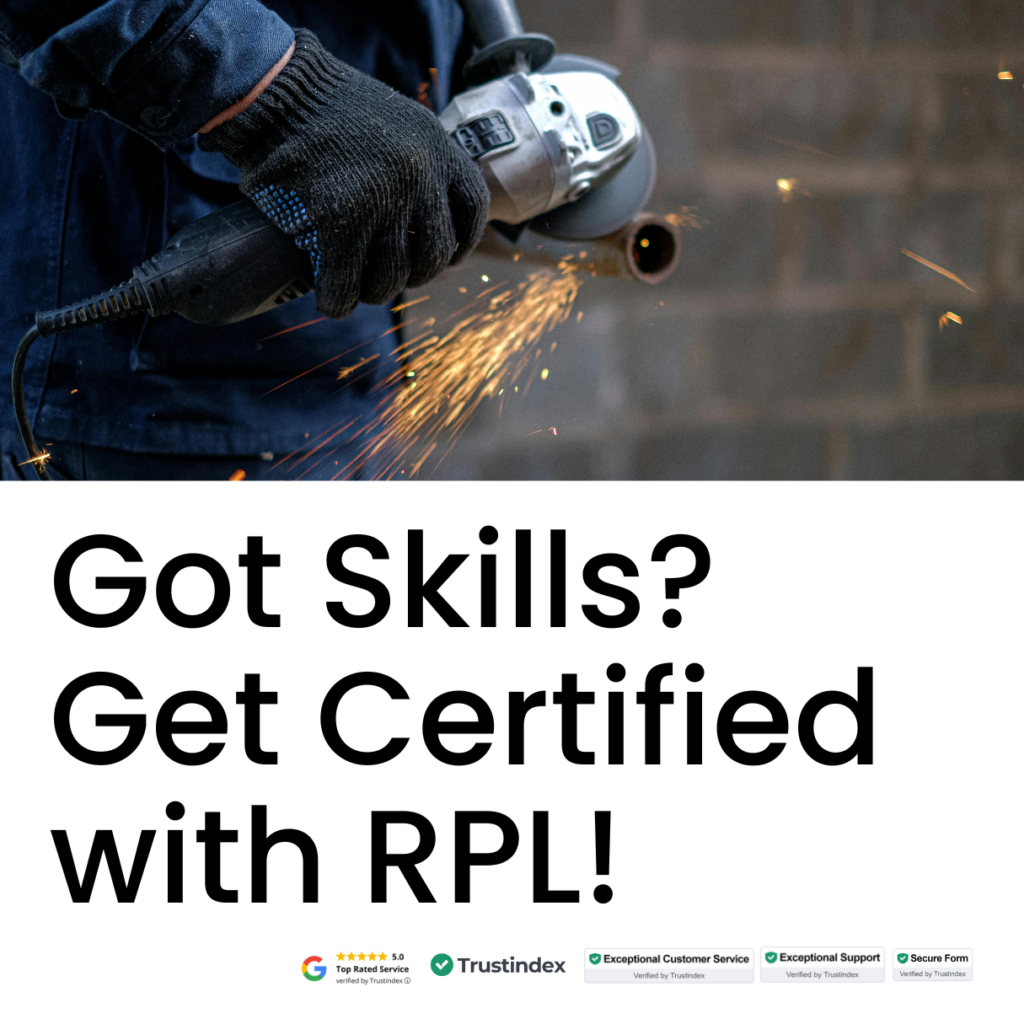Recognition of Prior Learning (RPL) can be a game-changer for professionals looking to fast-track their qualifications by leveraging their existing skills and experience. Whether you’re considering applying for RPL for the first time or simply want to understand how it works, we’ve compiled the most frequently asked questions to guide you through the process.
In this comprehensive FAQ, you’ll find clear, practical answers covering everything from eligibility and application procedures to evidence requirements, career benefits, and employer involvement. Each response is linked to detailed blog resources to help you dive deeper into any topic.
Let us help you navigate your RPL journey with confidence, so you can achieve nationally recognised qualifications without unnecessary delays or confusion.
1. What is Recognition of Prior Learning (RPL), and how does RPL work?
Answer:
Recognition of Prior Learning (RPL) is a formal assessment process that evaluates your existing skills, knowledge, and work experience. Instead of attending traditional classroom courses, RPL allows you to gain nationally recognised qualifications by demonstrating your competency against qualification standards. The process involves submitting evidence and having it assessed by an accredited Registered Training Organisation (RTO). Learn more about the RPL process and eligibility in What is RPL and How Does It Work?.
2. Who can apply for RPL, and what makes someone eligible for RPL?
Answer:
Anyone with relevant work experience, informal training, or prior learning in a specific field can apply for RPL. Eligibility typically requires you to demonstrate that your skills and knowledge meet the competency standards of the qualification you seek. For example, you generally need at least 1–2 years of relevant experience, although requirements vary by qualification and the RTO. For detailed eligibility guidance, see How to Apply for RPL: A Step-by-Step Guide for Success.
3. Do I need formal education to apply for RPL?
Answer:
No formal education is necessary. RPL recognises skills and knowledge gained through work experience, informal learning, volunteering, and life experiences. This makes it ideal for those who may not have completed traditional qualifications but have developed competencies on the job. For detailed guidance, see RPL Application: What to Expect and How to Prepare.
4. What qualifications can I gain through RPL?
Answer:
You can obtain nationally recognised certificates, diplomas, and advanced diplomas across a wide range of industries, including business, construction, hospitality, IT, community services, engineering, and more. Explore qualification options on the Recognition of Prior Learning (RPL) page. Learn more about Navigating the RPL Process: A Comprehensive Guide.
5. Is RPL nationally recognised in Australia?
Answer:
Yes. All qualifications issued through RPL by accredited RTOs are nationally recognised under the Australian Qualifications Framework (AQF), ensuring your skills and credentials are accepted by employers, industry bodies, and regulatory agencies.
6. Is RPL recognised worldwide?
Answer:
RPL qualifications are increasingly recognised internationally, especially in countries with structured skills recognition frameworks. However, recognition can vary depending on local regulations and industry requirements. Many international agreements and organisations, like the International Labour Organisation (ILO), support RPL systems globally. For more on global recognition, see Is RPL Recognised Worldwide? Clearing Up the Confusion.
7. How is RPL different from traditional education?
Answer:
Unlike traditional education, which requires attendance in scheduled classes, RPL allows you to leverage your existing skills and experience to gain formal qualifications without unnecessary classroom study. It’s flexible, fast, and tailored to your career goals. Compare pathways in RPL vs Traditional Education: Which Pathway Is Right for You?.
8. What are the key benefits of RPL?
Answer:
RPL offers many benefits, including time savings, cost-effectiveness, recognition of informal learning and volunteer work, career advancement opportunities, and no need for lengthy scheduled classes. Learn about RPL benefits in Key Benefits of RPL That Will Propel Your Career Forward.
9. How can RPL save time and money in my career?
Answer:
RPL reduces or eliminates the need for redundant study by recognising your existing competencies, saving you time and tuition fees. This faster qualification path can lead to earlier career advancement and higher earnings. See more in How RPL Can Save You Time and Money in Your Career.
10. Can RPL help me transition to a new career path without starting over?
Answer:
Yes. RPL recognises transferable skills and prior experience, enabling you to qualify for new roles without beginning formal education from scratch. It supports career changers by validating their competencies efficiently. Explore this in How RPL Can Help You Transition to a New Career Path Without Starting Over.
11. How do I apply for RPL, and what is the first step in the RPL process?
Answer:
Applying for RPL starts with a Free 40-Second RPL Skills Assessment that evaluates your existing skills and matches you to relevant qualifications. Following this, you prepare and submit an evidence portfolio for assessment by an accredited RTO. Get detailed guidance in How to Apply for RPL: A Step-by-Step Guide for Success.
12. What documents do I need to submit for RPL?
Answer:
Typical documents include your resume, reference letters, work samples, certificates, contracts, payslips, and identification. The exact requirements depend on the qualification and RTO. Learn how to gather evidence effectively in How to Gather and Submit RPL Evidence for Maximum Impact.
13. How do RTOs assess my RPL portfolio?
Answer:
Qualified assessors compare your submitted evidence against the competency requirements of the qualification. They verify the authenticity, relevance, sufficiency, and currency of your evidence to determine if you meet the standards. See what assessors look for in RPL Evidence: What Assessors Need to See.
14. What is an RPL experience portfolio, and how do I prepare it?
Answer:
An experience portfolio is an organised collection of documents demonstrating your skills and knowledge. Preparation involves gathering relevant evidence, organising it by competencies, and providing explanations or reflections linking the evidence to qualification requirements. Follow best practices in Creating an RPL Evidence Portfolio: How to Make Your Application Stand Out.
15. How long does the RPL process take?
Answer:
The process typically takes between 4 to 12 weeks, depending on the qualification complexity and how quickly you provide the required documentation.
16. What should I expect during my RPL application?
Answer:
During your RPL application, you will submit a portfolio of evidence demonstrating your skills and experience. An assessor from an accredited RTO will review your documents, may ask for clarifications or additional evidence, and determine if you meet the qualification requirements. The process is collaborative, and support is available throughout. For detailed insights, see: RPL Application: What to Expect and How to Prepare.
17. Can I apply for multiple qualifications through RPL?
Answer:
Yes, you can apply for multiple qualifications if your work experience and skills align with more than one qualification. Each qualification will require its own evidence portfolio and assessment process.
19. Is there a deadline to complete RPL?
Answer:
There is generally no strict deadline; however, it’s recommended to complete your portfolio and submit it within 2 to 4 weeks to avoid delays in the assessment process. Flexibility is usually offered to accommodate your circumstances.
20. Will I need to take tests or exams during the RPL process?
Answer:
Most RPL applications do not require formal exams or tests. However, if the assessor finds gaps in your evidence, you may be asked to complete short assessments or gap training to demonstrate competency. Learn more about assessments and gap training in: How to Apply for RPL: A Step-by-Step Guide for Success.
21. How often can I apply for RPL?
Answer:
There is no limit to how many times you can apply for RPL. You can apply for different qualifications whenever your skills and experience meet the requirements.
22. Can I get RPL for overseas work experience?
Answer:
Overseas work experience is acceptable for RPL applications. However, onshore Australian work experience is generally recommended. Acceptance depends on the specific Registered Training Organisation (RTO) and qualification requirements. STUDYIN consultants will advise you on your eligibility based on your profile.
23. Is volunteer work eligible for RPL?
Answer:
Yes, volunteer experience is eligible if it meets the competency standards and can be substantiated with evidence such as reference letters or documented work outcomes. For more guidance, see: Mastering RPL Evidence: Types, Rules, and Submission Tips.
24. Do I need Australian work experience to qualify for RPL?
Answer:
No, Australian work experience is not mandatory. Work experience from any country can be assessed if it aligns with the qualification competencies and is properly documented. However, onshore Australian work experience is generally recommended. Acceptance depends on the specific Registered Training Organisation (RTO) and qualification requirements. STUDYIN consultants will advise you on your eligibility based on your profile.
25. Can part-time or casual work be used for RPL?
Answer:
Yes, part-time and casual work experience can be included, provided it demonstrates the required competencies and is supported with appropriate evidence. For more guidance, see: Mastering RPL Evidence: Types, Rules, and Submission Tips.
26. What is the minimum experience required to be eligible for RPL?
Answer:
Most qualifications require at least 1 to 2 years of relevant work experience. Specific requirements vary by qualification and by the Registered Training Organisation (RTO).
27. What types of evidence are accepted for RPL?
Answer:
Common evidence includes resumes, reference letters, work samples, performance reviews, certificates, contracts, payslips, and training records. Evidence should be relevant, authentic, sufficient, and current. For a detailed explanation, visit: Mastering RPL Evidence: Types, Rules, and Submission Tips.
28. How do I gather and organise evidence for RPL?
Answer:
Gather documents that demonstrate your skills related to the qualification’s competencies. Organise evidence in a logical structure, label each piece, and include brief explanations. Use a qualification-specific checklist to ensure completeness. See practical tips in: How to Gather and Submit RPL Evidence for Maximum Impact.
29. What do RPL assessors look for in evidence submissions?
Answer:
Assessors verify that evidence is sufficient, authentic, reliable, and current. They look for clear links between your experience and the qualification’s competency standards. Learn what assessors expect in: RPL Evidence: What Assessors Need to See.
30. Do I need employer references for my RPL application?
Answer:
Yes, reference letters from current or past employers, supervisors, or colleagues help validate your skills and experience. Strong, detailed references improve your application’s credibility. Learn how to write effective references in: Winning Reference Letter for Your RPL Application.
31. How can self-employed applicants provide RPL evidence?
Answer:
Self-employed applicants can provide client testimonials, invoices, contracts, business registrations, tax records, or other documents demonstrating their work and competencies. See practical tips in: How to Gather and Submit RPL Evidence for Maximum Impact.
32. How much does RPL cost?
Answer:
RPL fees vary by qualification and units/specialisations selected. STUDYIN offers competitive pricing with a Best Price Guarantee and Price-Matching Policy tailored to your chosen qualification and evidence requirements. STUDYIN offers a Full Cashback Guarantee for your complete peace of mind.
33. Are payment plans available for RPL fees?
Answer:
Yes, flexible payment options and instalment plans are available on request to help manage costs.
34. Do I need to pay before knowing if I’m eligible for RPL?
Answer:
No. You can complete the Free 40-Second RPL Skill Assessment to check eligibility before committing financially. All consultations are completely free.
A partial payment is required to begin the RPL process, with the balance payable only before we release your soft copy certificate. Your certificate will be sent by registered post, securely packaged inside a STUDYIN Box for safe delivery.
35. Is RPL cheaper than full-time study?
Answer:
Generally, yes. RPL is more cost-effective since it reduces or eliminates the need for lengthy classroom study, saving tuition fees and time. Discover more in: How RPL Can Save You Time and Money in Your Career.
36. Do I have to pay for gap training if required?
Answer:
No, if gap training is recommended by the assessor to meet competency requirements, you may be required to complete short assessments or training sessions. This will be provided at no additional cost to you. Learn more about assessments and gap training in: How to Apply for RPL: A Step-by-Step Guide for Success.
37. Are RPL qualifications valid for employment or licensing?
Answer:
Yes, qualifications gained through RPL are nationally recognised and accepted by employers, licensing bodies, and industry regulators. According to the Australian Skills Quality Authority (ASQA), Recognition of Prior Learning (or RPL) is a legitimate part of the VET sector and the Australian education system. For more details, visit: Get Licensed & Build Your Future
38. Can RPL qualifications be used for Australian immigration or visa applications?
Answer:
Yes, many RPL qualifications are accepted by Australian immigration authorities for skills assessment, which is a crucial part of many visa application processes. However, acceptance depends on the specific visa subclass and the assessing authority involved. It’s important to ensure that your RPL qualification aligns with the standards set by the relevant assessing body.
Consulting a registered migration agent or immigration lawyer is recommended to confirm whether your RPL qualification will meet the criteria for your particular visa application. Learn more in: RPL for Australian Immigration: Eligibility and Process.
39. Will my RPL certificate differ from one earned through formal study?
Answer:
No. RPL certificates are identical to those earned through traditional study, with no mention of RPL on the qualification. Learn more: RPL vs Traditional Education: Which Pathway Is Right for You?
40. What happens if I fail my RPL assessment?
Answer:
During the initial consultation, we usually get a clear idea of your eligibility, so failing an RPL assessment is rarely an issue. We only proceed with your application when there is a solid basis to do so. However, if the assessor identifies gaps in your evidence, you may be asked to provide additional evidence or complete short assessments or gap training to demonstrate competency.
In the rare event that the RTO rejects your application, STUDYIN offers a Full Cashback Guarantee for your complete peace of mind.
41. How does RPL support career advancement and job security?
Answer:
RPL formalises your skills, making you more competitive for promotions, salary increases, and stable employment. Explore career benefits in: RPL: The Key to Career Advancement and Better Job Opportunities.
42. How does RPL support continuing professional development (CPD)?
Answer:
RPL helps you document and validate ongoing learning and skills development, contributing to CPD requirements in many professions. Learn more in: RPL and Continuing Professional Development (CPD): How RPL Plays a Role in Ongoing Career Growth.
43. How can RPL help me unlock new career opportunities?
Answer:
By gaining formal qualifications through RPL, you expand your job prospects, enter new industries, or pursue higher roles. Read more in: How RPL Can Help You Unlock New Career Opportunities.
44. Can I upgrade existing qualifications through RPL?
Answer:
Yes. If you have advanced skills or experience beyond your current qualification, RPL can help you achieve higher-level certifications. Read more in: RPL: The Key to Career Advancement and Better Job Opportunities.
45. How can STUDYIN help me with my RPL application?
Answer:
Choosing STUDYIN means partnering with an experienced and trusted RPL provider dedicated to your success. We offer personalised support throughout your RPL journey—from the initial Free 40-Second Skills Assessment to helping you build a comprehensive portfolio and guiding you through submission and assessment.
Our partnerships with nationally accredited Registered Training Organisations (RTOs) ensure that the qualifications you receive are recognised and respected across Australia. We guarantee the best price for your chosen qualification, with transparent fees and no hidden costs, along with a 100% money-back guarantee.
At STUDYIN, we prioritise a fast, flexible, and stress-free RPL process, allowing you to achieve your qualifications while maintaining your work and life commitments. Our expert consultants are available to answer your questions and provide tailored advice every step of the way.
All qualifications are awarded by our trusted partner RTOs.









